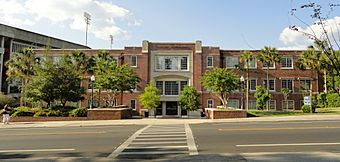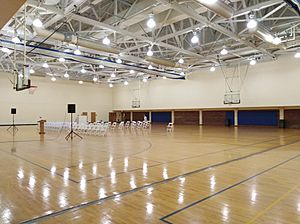Florida Gymnasium facts for kids
Quick facts for kids |
|
|
Florida Gymnasium
|
|
|
U.S. Historic district
Contributing property |
|
 |
|
| Location | Gainesville, Florida |
|---|---|
| Built | 1949 |
| Architect | Rudolph Weaver and Guy Fulton |
| Architectural style | Collegiate Gothic |
| Website | Official site: http://recsports.ufl.edu/locations/courts/florida-gym-basketball-courts |
The Florida Gymnasium, often called the Florida Gym, is a historic building at the University of Florida (UF) in Gainesville. It opened in 1949. This large building was once a 7,000-seat arena for many different activities.
For over 30 years, it was the main place for the Florida Gators men's basketball team. Other UF indoor sports also used it. During this time, it earned the nickname "Alligator Alley."
In 1980, the Stephen C. O'Connell Center opened. This new center took over as the university's main sports facility. The Florida Gym then slowly changed its purpose. It became home to the University of Florida College of Health and Human Performance (HHP). Many parts of the gym were updated. By the mid-1990s, it had modern classrooms, labs, and offices. A basketball court is still in the middle of the gym. It is used for small meetings and HHP classes.
Contents
The Florida Gym's Story
Early Sports Buildings
The University of Florida's first indoor sports building was the University Gymnasium. This narrow brick building opened in 1919. The school's men's basketball team used it for practice and games. However, it was mostly for student fun, so there wasn't much space for people to watch. By the mid-1920s, the university needed a bigger gym for its sports teams.
During the Great Depression, the university had less money. Building a new brick gym was too expensive. So, a wooden building called "Building R" was built instead. People usually called it the "New Gym." It was next to the old University Gym. This was meant to be a temporary home for the indoor sports teams. But because money was still tight in the 1930s, the Gator basketball teams used the New Gym for more than 20 years.
Building the Florida Gym
Plans for a larger gym started in the early 1940s. University architect Rudolph Weaver began the design. But the project was put on hold during World War II. After the war, Guy Fulton finished the plans. Construction began in 1947, and the Florida Gymnasium opened in 1949. It cost about $1.6 million to build.
Around the same time, the university started letting both men and women attend. The old University Gymnasium became the Women's Gymnasium. The "New Gym" was used for the university's marching bands to practice.
The Florida Gym was the second large indoor place on campus. The University Auditorium was the first. The gym was the only place big enough for all 10,000 students to gather. The building also had offices for the university's sports leaders. The College of Physical Education, Health and Athletics was also located there. For many years, students even registered for classes on the Florida Gym's court.
Why "Alligator Alley"?
As a sports venue, the Florida Gym quickly got a nickname: Alligator Alley. It was a tough place for visiting teams to play. The seats were very close to the court. When the gym was full, the noise was "deafening," meaning it was extremely loud.
However, the gym also had few comforts. There was no air conditioning. All of UF's indoor sports teams had to share the court. Over time, it started to seem small and old-fashioned. Some people said it looked more like an old high school gym than a major college arena.
By the early 1970s, Florida was the only school in its sports conference without a modern basketball facility. This made it harder to get top new players. It also slowed down the growth of the basketball program. So, in the mid-1970s, the university planned a new, larger sports arena. The O'Connell Center opened in December 1980. It became the new home for all of UF's indoor sports.
New Life for the Gym
The Florida Gymnasium slowly changed its purpose during the 1980s. The basketball court and nearby areas were used for student fun and occasional events. The College of Health and Human Performance also updated its facilities. The gym continued to be the place for class registration until the early 1990s. After that, students could register by phone or online, so they didn't need to go in person.
The gym was no longer needed for student recreation after 1990. A modern fitness center was built right behind it. Then, the much larger Southwest Recreation Center opened in 1994.
In the mid-1990s, the gym had a big renovation project. The old bleachers were removed. Much of the inside space was turned into modern classrooms, labs, and offices. The basketball court is still in the center of the building. It is used for College of Health and Human Performance activities and small events.
In 2008, the Florida Gymnasium became part of the University of Florida Campus Historic District. This district was added to the National Register of Historic Places in 1989.
See also
- Buildings at the University of Florida
- History of the University of Florida




